
Venereal Disease Treatment Menu: 1 2 3 4 5 6 7 8 9 10 11 12 13 14 Next>>
Venereal Diseases in the Golden Age of Piracy, Page 7
Treating VD During the GAoP: First Stage (The Clap) - Healing Venereal Sores
Please be aware that this page contains graphic depictions of the male anatomy.
Sea surgeon John Atkins explained that "Shankers are Venereal Ulcers on the Glans Praeputium [foreskin], or Fraenum [fold of skin]"1. In discussing his theories about the cause of a pox, Atkins wonders why an ulcer on the penis appears sooner than it normally does elsewhere on the body.
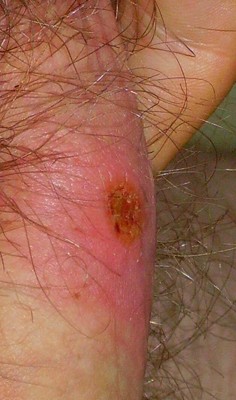
Photo: Eigenes Archive
Syphilitic Chancre on the Penis
In fact, these small, painless syphilitic sores appeared about three weeks after the infection. However, Atkins gives an explanation for why he thinks they pop up so quickly, which is "that the Heat raised and excited by Lust gives a Force and Activity to the Salts generated under the Corruption; whereas any other Ulcer, tho' never so virulent, cannot emit Effluvia's in such Force or Numbers, nor to Parts so susceptible of their Reception"2.
Every author under study recommends the cure for these types of ulcers. Sea surgeon John Woodall says that "for any pockie Ulcer on the yard, I mean either upon the glans [head], or præputum [foreskin], or twixt both, onely touch it but once with ...Aqua benedicta [water of the blessed thistle], and give the party one dose of your Aquilla [aqua] vitæ, and without question you shall cure it afterwards as if it were a greene [new] wound"3 .
Similarly brief in his recommendations, John Moyle discusses the treatment of a man with 'some small Ulcerations on the Glans [head of the penis] about the Frenum [membranous fold of skin]' of the penis. He explains that he first "washed the Chancers with Egiptiac. [Hypericum or St. John's wort flowers] & aq. Plantaign. [plantane water] Misce [mixed]. it was used warm."4 Alert readers will recognize this as being the same prescription he gave for curing buboes. He later mentions that while "the Ulcers was deterging, I made Venæ Section [bloodletting]. The Ulcerations on the Glans, healed in a little time, but that in the Inguen [crease at the junction of the thigh and groin] was longer [in healing], it was about 6 Weeks e're I could cure that"5. In fact, inguen ulcers are not caused by the same thing as the initial syphilitic ulcer that appeared on the penis. This may account for their taking longer to cure.
Both naval physician William Cockburn and sea surgeon John Atkins provide a variety of medicinal options to treat shankers/chancres. Atkins starts with a lotion base containing an ounce each of plantane and rose water, two ounces of White Lozenge of Rhasis. He then instructs the surgeon to mix 15 grains of one of the following mercury-based prescriptions into that base.
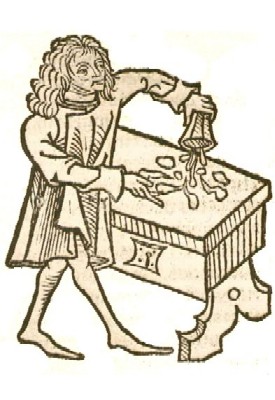
Pouring Out Mercury, From Hortus Sanitatis (1491)
Rx. Mer. Sublimate. {2 drams} dissolute [dissolve] in sp. Vin. {1/2 ounce} & filtretur. [filtered] Or,
Rx. Aq. Calcis [lime water] {1 ounce} Mer. sublimat. {1 dram} solute & filtretur [dissolve and filter] pro usu. [for use]
Rx. Un Basilic. [Basilicon Unguent] {1 ounce} Præcicpit rub. [red mercury precipitate] {1 dram} m. prop [mix quickly into] Unguento. [an unguent]
Dr. Cockburn's Arcanum: Rx. Hydrargyr. [mercury] Tereb. Venet. [Venetian Turpentine] an. P. Æ. [of each equal parts] F. Unguent. [make into an unguent]6
However, Atkins goes on to note that these topical medicines alone will not cure the shanker. He recommends eight to ten days of "Mercurials, to procure a Spitting: There is nothing these Symptoms better or sooner submit to; for as the Mouth grows sore, there follows a Mitigation, the Matter is diverted, the Chancres heal, and the Parts suddenly regain their pristine Form and Tension."7
In typical blustering form, Cockburn announces
I shall next communicate a Method, whereby Shankers are cured in a very little Time, with great Easiness, without any Pain, Inflammation, loss of Substance, and any Danger of Extirpating the Member, or any Part of it. This Medicine requires no help from other Medicines, it dissolving the Shanker, and Healing up the Part. ...The Method is short and easy, like the Medicine it self: For you are only to dress Shankers with this Ointment.8
The medicine turns out to be the last medicine Atkins mentioned - an uguent made from equal parts of mercury and turpentine. Cockburn spends quite a bit of time objecting to the use of potential cauterizing medicines to burn off the shanker. Like warnings against bleeding or purging patients with buboes, he explains that caustic medicines will fail to "destroy the Sharpness of a Gonorrhœa, which is the Cause of the Shanker, but merely to make the Shanker fall off" and drive the venereal taint back into the body to turn into a confirmed pox.9
Ironically, although this wouldn't be understood until long after the end of the golden age of piracy, all of this work ended up being for naught. As historian Claude Quétel explains, "the chancre heals spontaneously after a few weeks and that the disorders of the skin and the mucous membranes also eventually vanish, even in the absence of treatment"10.
1 John Atkins, Lues Venerea, not dated, p. 33; 2 Atkins, Lues Venerea, p. 6; 3 John Woodall, the surgions mate, 1617, p. 159; 4 John Moyle, Memoirs: Of many Extraordinary Cures, 1708, p. 82; 5 Moyle, Memoirs, p. 84; 6 John Atkins, The Navy Surgeon, 1742, p. 238; 7 Atkins, Navy Surgeon, p. 239; 8,9 William Cockburn, The Symptoms, Nature, Cause and Cure of a Gonorrhoea, 1713, p. 157; 10 Claude Quétel, History of Syphilis, 1990, p. 86
Treating VD During the GAoP: First Stage (The Clap) - Gonorrhea Theory
The other part of the Clap in the Universal Source Theory were gonorrheal symptoms. This section looks first at some of the theory behind the cause of this stage, then describes of the symptoms identified with it and finishes with an explanation of the cures recommended by sea surgeons and physicians.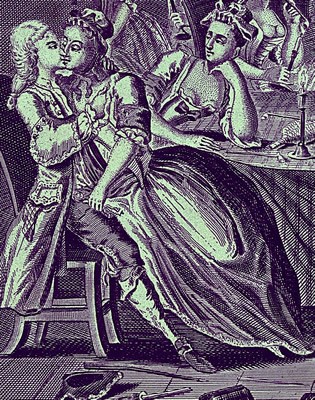
Artist: Thomas Bowles
The Rake Carouses in a Tavern Full of Prostitutes (1735)
Atkins begins by insisting that venereal contact is necessary to contract gonorrhea. He explains that "it is a very unlikely Thing for Venereal Matter ever to do it without" some form of sexual contact.1 Atkins is here protesting against the idea that venereal diseases could be transmitted in other ways which would be safe from the moral condemnation which accompanied most cases of venereal disease at this time. He mentions a few he rejects including "by [a man] only taking the corrupted Matter from her Body in her Hand, and wetting his Privities. And others relate its highest Degeneracy, or a Pox to be contagious, by wearing the Cloaths, Lying, or Cohabitation"2. He goes on to explain that in such claims, "Fact Baffles Philosophy. And if all those who have suffered this Way [of venereal diseases], are like what have fallen to my Share [to cure], there is not one could stand by any other Pretence than Coition."3
Atkins further objects to the idea that venereal diseases can be transmitted as some other diseases appear to be, where "Animalculæ are bred in those Globules dispersed about the Skin, which making their Way through, shift from Place to Place, and so carry Infection, they living (says the Relation [of those espousing the non-venereal contact theory]) two or three Days when from the Body."4 Instead, Atkins suggests that the transmission agents are "dispersed about the Vagina, are volatiliz'd [converted into fine particles or vapor] and made fitter for Communication by the Heat of Lust, and received by the enlarged Pores of the Penis, where, by their Pointedness, they shortly effect an Erosion."5 He explains that the venereal "Parts are relaxed and made more easily susceptible of any Venom to be transmitted, and that again from her [his partner] becomes enabled to insinuate and escape through the Pores by the Pungency of their Salts, and Power they are darted with"6. Atkins also points out that the enormous relaxation which accompanies sexual congress makes the sexual organs all the more receptive to 'morbifick matter'.
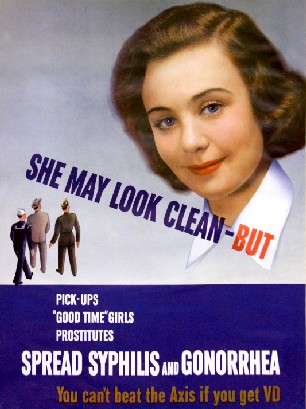
Image: U.S. National Archives and Records Administration
Some Things Never Change... World War II Syphilis
& Gonorrhea
Warning Poster (1941-5)
Alert readers may notice that Atkins' statements suggest women carry much of the blame for the spread of the disease. This comes (not entirely unfairly) from the belief that places the blame for its spread on prostitution.7 However, it completely fails to recognize the culpability of men in the trade.
Cockburn's book suggests something quite different regarding the infectiousness of the sexes. He says that "Woman receive a Million Times more Contagion [during copulation than men]; yet escape clear from being Infected with a Gonorrhœa."8 He says that this is because "the Contagious Liquor [liquid] is conveyed from a Man, blended with another Liquor in quantity far exceeding the Poysonous Liquid"9. He notes that the 'other' liquor is soft and sticky and "therefore the sharp contagious Parts may be so blunted... as altogether to defeat its ordinary Effects; especially in the Time they both remain in the Vagina"10. In addition, he states that menstruation carries the liquid out, which also "washes, and dissolves this Acrimonious Infection"11. Cockburn goes on to say that men are easily infected basically because they come in contact with a less diluted form of the contagion. However, he also notes that gonorrhea "is infectious and communicable by either of the Sexes to the other"12, so that although he feels women are less likely to be infected, they clearly can be.
The curious belief that women often did not contract gonorrhea likely stems from the fact that women are much less likely to display symptoms of the disease than men. Although they don't provide statistics, the CDC's website says, "Some men with gonorrhea may have no symptoms at all." It later adds, "Most women with gonorrhea do not have any symptoms. Even when a woman has symptoms, they are often mild and can be mistaken for a bladder or vaginal infection."13
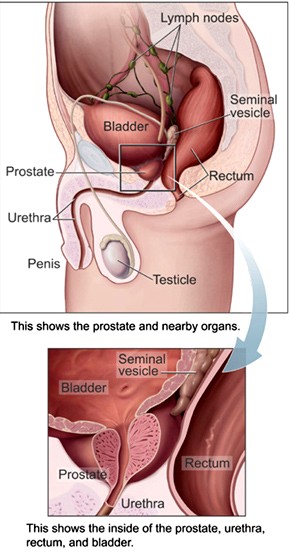
Source: U.S. Government
Diagram of Prostate and Nearby Organs. Note that 'the seed
bladders'
refer to the testicles, not the actual bladder.
Cockburn's explanation of the cause of gonorrhea focuses on the sources of the fluid (pus) discharge which is the primary observable symptom of gonorrhea. He spends a great deal of time discussing other authors' theories, going back and forth over them and concluding that the other authors are basically wrong.14 After a roundabout argument for and against various origins for gonorrhea, Cockburn finally concludes that "the Prostatæ, Seed-Bladders [testicles] and Parastatæ [shaft of the penis], [are] fit enough to produce a Gonorrhœa, by the help of a small Quantity of Poyson"15, which he quickly follows with the statement "we are under no Difficulty to assert, that the Sea of a Gonorrhœa is not in the Prostatæ, Seed-Bladders or any Parts beyond them."16 So, in the end, he really draws no conclusion at all other than everyone else who proposed a source for the disease is wrong.
Atkins disagrees with Cockburn, explaining that "A Virulent Gonorrhaea or CLAP, is the Emission of infectious Matter from the corroded Glandulae Prostatae, or those of the Urethra, accompanied with a DISURIA [dysuria - painful urination]."17 Although he tends towards pragmatism and is slight on theoretical detail, sea surgeon John Moyle similarly says "when the Malign Atoms [which cause venereal diseases]...lyes about the Genitals and Seed Vessels [testicles], then Nature seeks to expel it thereabouts."18 Like Atkins, he explains that this occurs via the running and dysuria which are signs of gonorrhea.
Humors play a part in these period theories about the cause of gonorrhea as they did with most golden age diseases. The pus flowing from the urethra was naturally felt to be humoral in nature. Atkins explained that a benign form of gonorrhea was "an Emission of Humour from the Glandulae prostatae, a Weakness only, and commonly proceeding from great Strains, and where the natural Strength has been too far exerted in any sort, whether by Labour or Venereal Pleasures"19. (Curiously, this suggests there was a non-venereal form of gonorrhea, something he said was not possible elsewhere.) Atkins also suggested that it was possible to contract gonorrhea non-venereally because "all Parts of the [are] Body Porous, and by many Experiments receptive of any proper Matter incumbent on them, conveying and mixing a Portion with the Humours of the Body"20. Cockburn identifies Gonorrhea as a humor which is by "far the most Corrosive... the acrimonious Liquor [liquid], communicated in a Gonorrhœa; causes a Discharge of the Liquor flowing out of these ducts [the urethra] in a certain Proportion to this stimulating power"21.
1,2 John Atkins, The Navy Surgeon, 1742, p. 225; 3,4 Atkins, Navy Surgeon, p. 226; 5 John Atkins, Lues Venerea, not dated, p. 11-2; 6 Atkins, Lues Venerea, p. 12; 7 See Charles Camblos Norris, Gonorrhea in Women, 1917, pp. 19-22; 8 William Cockburn, The Symptoms, Nature, Cause and Cure of a Gonorrhoea, 1713, p. 90; 9 Cockburn, p. 90-1; 10 Cockburn, p. 91; 11 Cockburn, p. 92; See Cockburn, p. 92; 12 Cockburn, p. 2; 13 "Gonorrhea - CDC Fact Sheet", cdc.gov/std/gonorrhea/stdfact-gonorrhea.htm, gathered 4/26/18; 14 See William Cockburn, The Symptoms, Nature, Cause and Cure of a Gonorrhoea, 1713, Chapters III and IV. Or better yet, don't.; 15 Cockburn, p. 34; 16 Cockburn, p. 35; 17 Atkins, Lues Venerea, p. 16; 18 John Moyle, Chirugius Marinus: Or, The Sea Chirurgeon, 1693, p. 137; 19 Atkins, Lues Venerea, p. 16; 20 Atkins, Lues Venerea, p. 13; 21 Cockburn, p. 53-4
Gonorrhea During the GAoP: First Stage (The Clap) - Gonorrhea Symptoms
The CDC identifies three symptoms of gonorrhea infection in men: uncontrollable fluid running from the urethra, painful urination or dysuria and swollen or inflamed testicles. They note that the last symptom is less common than the other two.1 The first two symptoms are identified by all of the golden age of piracy era sea and navy medical men who discuss gonorrhea, while the last is only mentioned by sea surgeon John Atkins.
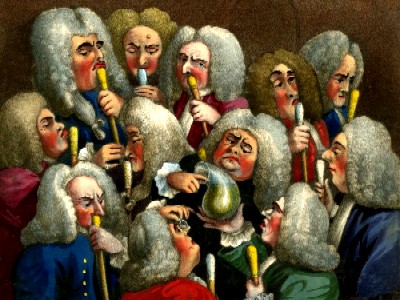
Artist: William Hogarth
"A Consultation of Physicians or The Company of Undertakers" (1737)
Because the various symptoms of venereal diseases were treated medically in different ways, it is possible to separate them by topic. However, it should be understood that they were still felt all to be part of the first stage of the same Universal Venereal Disease. While naval physician William Cockburn and Atkins both discuss gonorrhea in ways that make it sound as if they felt it were a separate illness, they also bundle symptoms of various other sexually transmitted diseases in with those specific to gonorrhea and explain that improper treatment of the first stage infection will allow the illness to progress to the second stage.
Perhaps the most common symptom of gonorrhea is the flow of pus from the urethra. In fact, sea surgeon John Moyle simply refers to it as "a Gonorrhæa, or Running at the Yard [penis]."2 Atkins says a "virulent Gonorrhæa, or Clap, is the Emission of infectious Matter from the corroded Glandulæ Prostatæ [prostate], or those of the Urethra, accompanied with a Disuria, or, in other Words, the involuntary Flowing of Matter through the Urethra"3. Cockburn explains that a "Virulent Gonorrhœa shows it self by an Efflux of a whitish, yellow, or green Liquor, that is made constantly out of the Penis with and without an Erection of that Member... The Quantity of this Liquor runs out much the same, whether the infected People are asleep or awake."4
As Cockburn's comment suggests, there is much interest in the color of the pus among the period doctors. Atkins assigns some importance to the "Consistence and Colour in the Running, (as Yellow, Green, or the like) or Pain in Water, are what we may take the Measure of Virulency from, and will be found more or less, in different Subjects, according to the Malignity of the infected Person, and Constitution of the Receiver."5
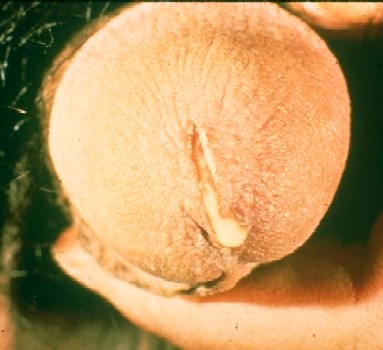
Yellowish Pus Discharge from the Penis in Gonorrhea
Cockburn assigns even more significance to the color. He explains that if the running fluid were corrupted by venereal taint, "it must run out in the Colour it always does when Corrupted, or it must run out
Yellow or Green", although, he admits, that it doesn't always do so, sometimes starting out white.6 This, he notes, becomes thinner (less viscid) and turns yellow or green.
Cockburn reasons, that the "Yellowness is partly owing to the Yellow Liquors of our Blood, and to the acrimonious Salts that produce a Gonorrhœa. ...it is manifest, how Gall, mixing with the Liquor [liquid running out of the urethra], makes it run out in a Yellowish Colour."7 In humor theory, the gall bladder was thought to produce the yellow bile humor, which helps explain his thought process. Cockburn goes on at length in a similar fashion about the yellow color finally declaring "that this corrosive, yellow, Substance is an Acid: Because it becomes Green (the other Colour of the Runing) by the Mixture of the Salt in the Urine or Alkali"8. From this, Cockburn concludes: "The Augmentation of the deepness of the Colour... arises from the continual Increase of the Quantity of the infecting Salts, whose Proportion to the Quantity of Fluids becomes every Day greater."9
John Atkins also discusses changes in color to this running, although not in such vivid detail. He simply explains that one of the signs that a gonorrhea has been healed is "when the Running is of thick and equal Consistence, changed in Colour, and lessen’d in Quantity"10.
The other symptom everyone discusses is painful urination. Moyle has the least to say,

Artist: Adriaen Jansz van Ostade - "Der pissende Bauer", (1660s)
simply noting that gonorrhea is accompanied by "pricking in the Yard when the Man makes water"11. Atkins calls it by name, even if he misspells it. "A Disuria is a necessary Consequence of the Running [pus], it being a Pain from the acrimonious Salts of Urine washing through the Parts which that has excoriated."12 He has clearly taken a page from Cockburn. Speaking of whom, Cockburn's explanation of what he suspects causes a dysuria blames the running pus for the problem, explaining that this "Virulent Liquor Corrodes the Passages of the Penis and Vagina it runs over; and excites so great a Sharpness in making Water"13.
As noted above, Atkins alone mentions the last, and less frequently encountered, symptom of gonorrhea: inflammation of the testicles. He does not highlight it as a symptom as he did with the running pus and dysuria, however, merely explains that when curing a gonorrhea, if treatment is stopped before the cure is completed, "acute Pain, Tumor, and Inflammation of the Groin or Testicles... may prove of as [an] unhappy Consequence"14. Probably as a result of the rareness of this symptom, Atkins chooses to call it a consequence of incorrect treatment, although he does seem to consider it to be a sort of late-stage symptom. He goes on to state that he does not consider the cure of gonorrhea to be complete unless the two previously mentioned symptoms have ceased and there is an "Absence of Pain, and Soreness about the Groin and Testicles"15.
1 "Gonorrhea - CDC Fact Sheet", www.cdc.gov, gathered 5/6/18; 2 John Moyle, Chirugius Marinus: Or, The Sea Chirurgeon, 1693, p. 138; 3 John Atkins, The Navy Surgeon, 1742, p. 230; 4 William Cockburn, The Symptoms, Nature, Cause and Cure of a Gonorrhoea, 1713, p. 2; 5 Atkins, Navy Surgeon, p. 230; 6 Cockburn, p. 55; 7 Cockburn, p. 56; 8 Cockburn, p. 57-8; 9 Cockburn, p. 58; 10 Atkins, Navy Surgeon, p. 235; 11 John Moyle, Abstractum Chirurgæ Marinæ, 1686, p. 91; 12 Atkins, Navy Surgeon, p. 230; 13 Cockburn, p. 2; 14,15 Atkins, Navy Surgeon, p. 235

